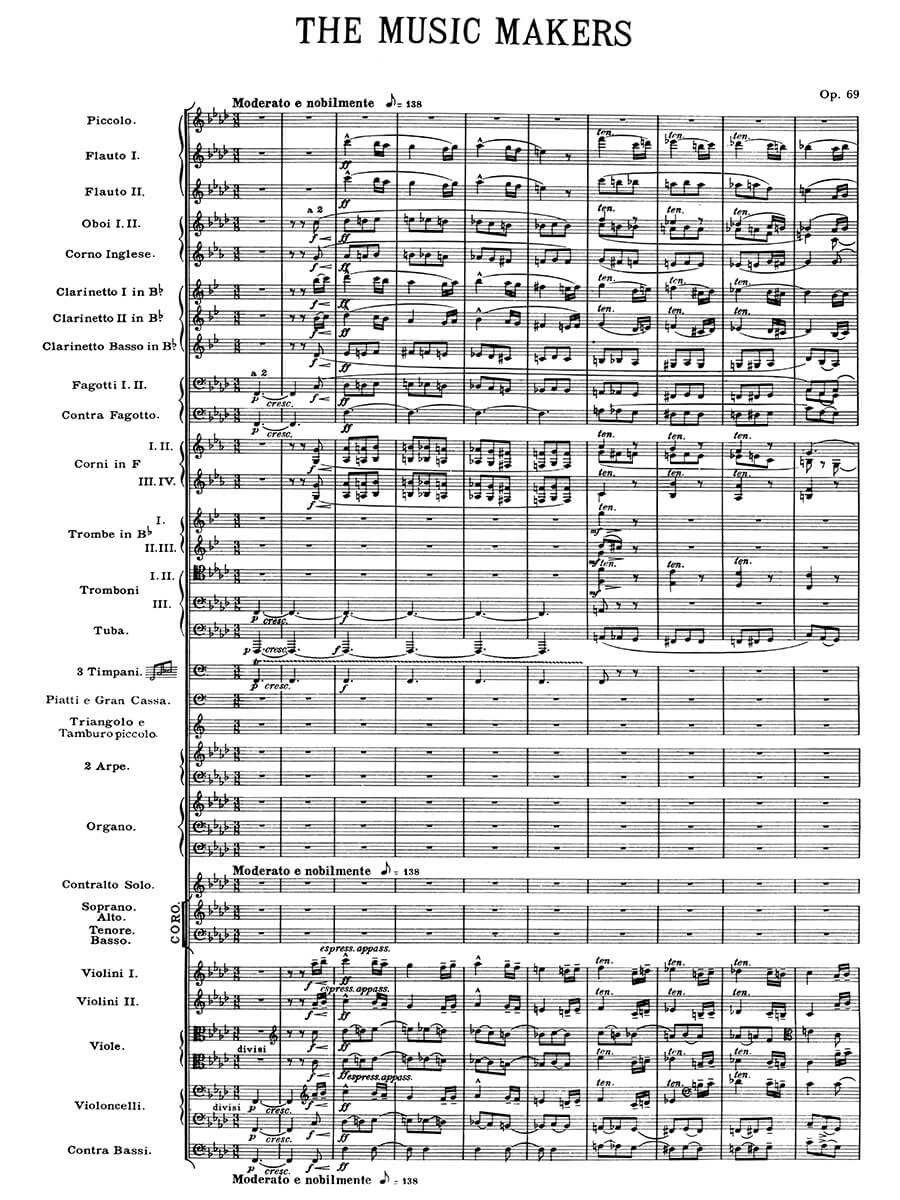The Music Makers Op. 69, Ode for contralto or mezzo-soprano, mixed chorus and orchestra
Elgar, Edward
27,00 €
Preface
Edward Elgar – The Music Makers, Op. 69
(b. 2 June 1857, Broadheath, Worcestershire – d. 23 February 1934, Worcester)
Ode for contralto or mezzo-soprano, mixed chorus and orchestra
Preface
Elgar had several commissions for choral works for the Birmingham Triennial Festival – The Dream of Gerontius (1900) The Apostles (1903), and The Kingdom (1906) are best-known. The Music Makers was commissioned for the 1912 festival. In the meantime Elgar’s life had changed dramatically. In the realm of music he had become a national figure such that new works created a sense of expectation, and newspapers carried long analyses of them. In his personal life, he had moved to London, living in a huge home in Hampstead that he named Severn House. But he was not very happy there, and his health – especially his mental health – suffered. He became prone to depression, migraines and problems with his hearing.
Despite all this, it was during this period that Elgar wrote some of his greatest works – the two symphonies (1908 and 1911) and the Violin Concerto (1910). In particular, he made it clear all three were partly autobiographical. So it was hardly surprising that he chose to set for Birmingham a text about the loneliness of the creative artist. The poet was Arthur O’Shaunessy (1844-1881). And moreover, Elgar chose to illustrate passages using self-quotation. He was not the first composer to do this – Richard Strauss used self-quotation heavily in Ein Heldenleben (1898) which had attracted much criticism for doing it.
This is the main problem with The Music Makers. Elgar’s style was changing, becoming more ‘spare’, and would culminate in the Cello Concerto of 1919. Part of that change involves a heavy reliance on very short sequential figures (much the same happens in later Fauré) and this newer style contrasts with the more melodic style of the works Elgar quotes. This contrast can be too much for some, and The Music Makers has always been the poor relation among Elgar’s mature works.
But in fact it gives great insight into the Elgar of 1912, particularly in relating the earlier works to personalities, and it rewards careful study. Perhaps the most obvious example occurs at the lines:
But on one man’s soul it hath broken,
A light that doth not depart;
And his look, or a word he hath spoken,
Wrought flame in another man’s heart.
Very quietly we hear the opening of Nimrod from the Enigma Variations as Elgar remembers Augustus Jaeger, and his “help and inspiration” as Elgar put it. Then the music transforms almost magically into the last movement of the second symphony, leaving us pondering its ‘meaning’ to the composer. One clear muse during this period was Alice Stuart-Wortley, whom he had known since 1905. We do not know that Elgar ever had an affair, but he certainly was very close to this second Alice, and her inspiration lies behind the Violin Concerto and the Second Symphony. It probably lies behind The Music Makers as well. On the day he completed it Elgar wrote to his second Alice (whom he called the ‘Windflower’): “Yesterday was the usual awful day which inevitably occurs when I have completed a work: it has always been so, but this time I promised myself ‘a day’! – I should be crowned – it wd. be lovely weather – I should have open air & sympathy & everything to mark the end of the work … But … it was bitterly cold – I wrapped myself in a thick overcoat & sat [on Hampstead Heath] for two minutes, tears streaming out of my cold eyes and loathed the world – came back to the house – empty & cold – how I hated having written anything: so I wandered out again & shivered & longed to destroy the work of my hands – all wasted…”
The Music Makers was first performed, conducted by the composer, at the opening concert of the Birming-ham Festival on 1 October 1912, in which Jean Sibelius also conducted his Fourth Symphony. …
Read full preface / Komplettes Vorwort lesen > HERE
Score Data
| Edition | Repertoire Explorer |
|---|---|
| Genre | Choir/Voice & Orchestra |
| Size | 210 x 297 mm |
| Printing | Reprint |
| Pages | 100 |
